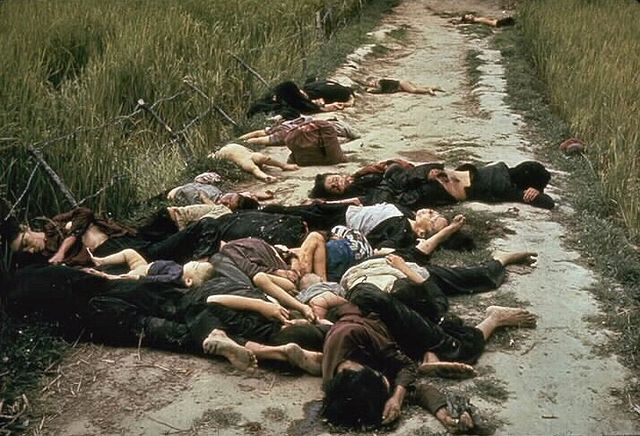 |
This is a file from the Wikimedia Commons. Information from its description page there is shown below.
Commons is a freely licensed media file repository. You can help.
|
Summary
| Description |
English: Photo taken by United States Army photographer Ronald L. Haeberle on March 16, 1968 in the aftermath of the My Lai massacre showing mostly women and children dead on a road.
|
| Date |
16 March 1968 |
| Source |
Copied from Krysstal.com, "The Acts of the Democracies" http://www.krysstal.com/democracy_vietnam_mylai.html |
| Author |
Ronald L. Haeberle |
Permission
( Reusing this file) |
| Public domainPublic domainfalsefalse |
 |
This image is a work of a U.S. military or Department of Defense employee, taken or made as part of that person's official duties. As a work of the U.S. federal government, the image is in the public domain.
|
|
See also discussion of copyright status there.
The photo is copied and used in many places which mention the massacre. This particular image was copied from the KryssTal Web Site (which also shows more graphic alternate images).
According to Camilla Griggers, professor of Visual Communication and Linguistics at California State University, Channel Islands:
- The Army photographer, Ronald Haeberle, assigned to Charlie Company on March 16th, 1968 had two cameras. One was an Army standard; one was his personal camera. The film on the Army owned camera, i.e., the official camera of the State, showed standard operations that is, 'authorized' and 'official' operations including interrogating villagers and burning 'insurgent' huts. What the film on the personal camera showed, however, was different. When turned over to the press and Government by the photographer, those 'unofficial' photographs provided the grounds for a court martial. Haeberle's personal images (owned by himself and not the US Government) showed hundreds of villagers who had been killed by U.S. troops. More significantly, they showed that the dead were primarily women and children, including infants. These photographs exposed the fact that the 'insurgents' in popular discourse about Vietnam were actually unarmed civilians. The photos made visible to viewers that the 'enemy' in Vietnam was actually the indigenous Vietnamese population.
According to John Morris, the photo editor for The New York Times at the time, Haeberle claimed that the images on his personal camera were his own copyright, but the Times and other publications printed them without payment in the "public interest", and also arguably in the public domain, produced by the U.S. Army:
- Haeberle's pictures were arguably government property ... I guessed that Life was unlikely to pay more than $25,000 (in fact, it paid $20,000) ... In late morning, we received word that London papers, copying the photos from The Plain Dealer, were going ahead without payment, ignoring the copyright. The New York Post followed, in its early afternoon edition. Rosenthal decreed that it would now be ridiculous for The Times to pay. We would publish "as a matter of public interest.
|
- ↑ Krysstal.com, "The Acts of the Democracies" http://www.krysstal.com/democracy_vietnam_mylai.html
- ↑ Camilla Benolirao Griggers, "War and the Politics of Perception," chapter 1 from the essay Visualizing War, taken from http://www.planznow.com/texto4.html
- ↑ Pg 36 - Morris, John G. (Summer 1998). "Get the Picture: A Personal History of Photojournalism". The Nieman Foundation for Journalism vol. 52 (no. 2): 32-38. Bill Kovach. ISSN 0028-9817. Retrieved on April 17, 2010.
Licensing
| Public domainPublic domainfalsefalse |
 |
This image is a work of a U.S. Army soldier or employee, taken or made as part of that person's official duties. As a work of the U.S. federal government, the image is in the public domain.
|
|
Other versions
File usage
The following pages on Schools Wikipedia link to this image (list may be incomplete):
SOS Childrens Villages chose the best bits of Wikipedia to help you learn. SOS Childrens Villages helps more than 2 million people across 133 countries around the world. There are many ways to help with SOS Childrens Villages.





